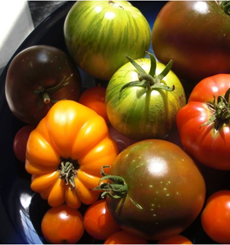TIP OF THE DAY: Make A Triple Heirloom Tomato Salad

A tomato salad feast. Photo courtesy |
A tomato lover’s favorite months should be August and September, when the crop of vine-ripened tomatoes yields exquisite bounty.
We splurge on $4/pound heirloom tomatoes (that’s the New York City price—don’t let it scare you if you live elsewhere), which are available at our farmers market in a wide variety of colors, shapes, flavors and sizes. We buy Aunt Rubys, Black Russians, Brandywines, Cherokee Purples, German Stripes, Green Zebras, and our favorite name tomatoes, Mortgage Lifters, which were bred in the 1930s by a West Virginia farmer who needed cash to pay off his mortgage. Don’t be put off by cracked skin at the stem end: The tomato is still delicious. You can peel the skin or slice off the end. When this “fault” of numerous tomato varieties was bred out to create perfect-looking tomatoes, much flavor was bred out with it. Tomatoes should be a flavor competition, not a search for perfect skin. |
|
|
Once you’re in front of the tomato selection, pick three and create a triple-heirloom-tomato salad.The inspiration for this recipe comes from chef Mauro Colagreco, whose two-Michelin-stars restaurant, Mirazur, in Menton on the French Riviera, has views as exquisite as the food. Here’s the original recipe. Use three different heirloom varieties, contrasting color and flavor. TRIPLE-HEIRLOOM-TOMATO SALAD This is a wonderful first course. When you purchase the tomatoes, make sure that you have one tomato at least three inches in diameter that can be cut into four slices, a half-inch or thicker, to serve as a base for the other ingredients. Serves four. Ingredients 1. HERBS. Make a paste of herbs: In a mortar and pestle or food processor, grind/pulse herbs to a paste. Add a small amount of olive oil and a pinch of salt to season. If you make more than 1/4 cup, the leftover paste will keep in the fridge for several days. You can use it as a garnish with just about anything, including as a sandwich spread, in potato salad, mixed into rice, scrambled eggs and other everyday dishes. 2. BALSAMIC. Prepare the balsamic reduction. You can substitute a purchased balsamic glaze. 3. TOMATOES. Slice the “base” tomato into four slices. Cut the other tomatoes into the size of halved cherry tomatoes or large dice. Some tomatoes may need to be seeded before cutting into small pieces. Add a pinch of salt and the fresh thyme to the cut tomatoes and arrange atop the base, leaving a space in the center for the greens. 4. SALAD. Lightly dress with olive oil and a pinch of sea salt. There is no vinegar because the great flavor of heirloom tomatoes should shine through, and the salad can be dipped into the balsamic reduction. However, if you are using tomatoes that need a kick of flavor, or don’t want to make the balsamic reduction, you can substitute a balsamic vinaigrette. 5. FINISH. Using squeeze bottles or medicine droppers, surround the tomato base with an artistic array of herb and balsamic droplets (see photo above). Serve and celebrate the glory of tomatoes. |
||
|
WHAT IS AN HEIRLOOM TOMATO?
An heirloom tomato is a non-hybrid (open-pollinated) tomato cultivar (variety). It has the deep, lush flavor that tomatoes were meant to have, before they were bred (hybridized) to have perfect shapes, bright red colors, disease-resistance while growing and shipping and long shelf life, among other qualities. Even if you eat freshly-picked, vine-ripened tomatoes lovingly grown from seedlings in your own garden—far superior in flavor to store-bought tomatoes that have traveled a distance—the flavor is just a fraction of a tomato grown from heirloom seeds. The period following World War II marks the beginning of industrial agriculture, with a focus on breeding produce and livestock for commercial convenience. Flavor was victim to economics in the commercial seed business. |
 Heirloom tomatoes: summer jewels. Photo courtesy GreenAccessAtSuncadia.com. |
|
|
For small farmers who fought to maintain quality, heirloom seeds have been nurtured and handed down through the generations, going back 100 years and longer.
|
||


